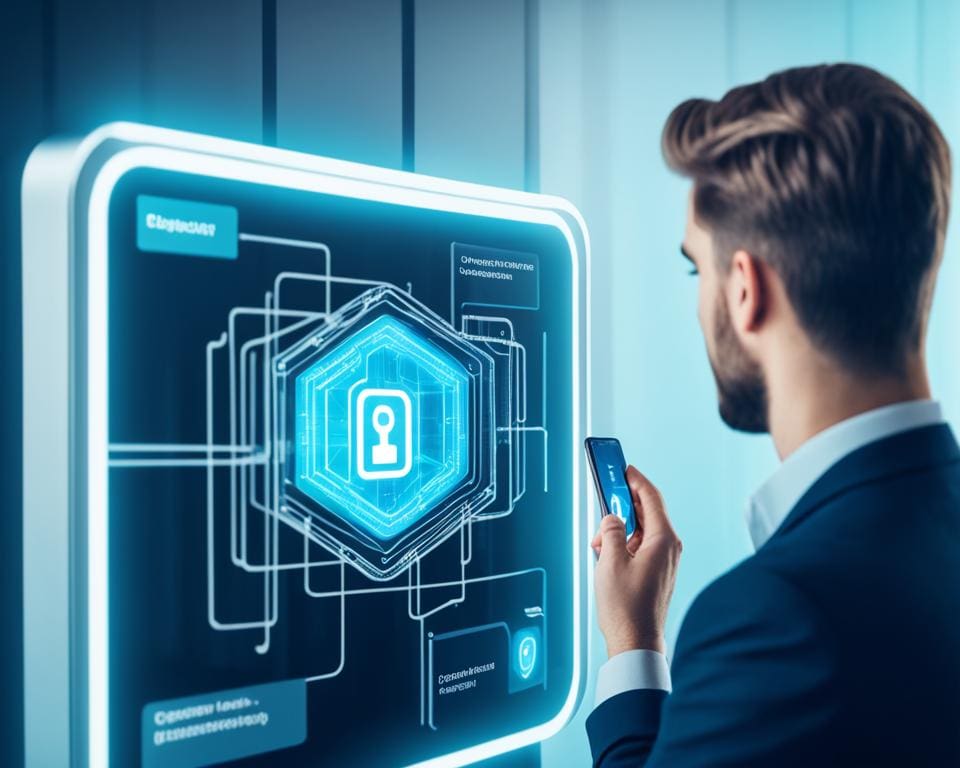Blockchain technology is reshaping how we handle our online identities. With identity theft and fraud costs hitting billions yearly, it’s clear we need better security. Traditional systems face problems like data breaches and unwanted data sharing. Dave Balroop from TechUnity puts it well, “Blockchain offers a decentralized, secure, and transparent framework for digital identity management.”
Introduced in 2008, blockchain was meant to secure currency. Now, it’s doing much more. It protects our identity data from theft and fraud. This means we can control our information confidently. With blockchain, verifying identities becomes safer and easier for everyone involved.
Understanding Digital Identity in a Connected World
In our world today, digital identity has become key for daily online interactions. It’s all about the information that shows who we are online. This can be personal details, what we do, and how we connect on various sites. With more of our lives happening online, knowing and handling our digital selves is more important than ever.
Definition and Importance of Digital Identities
Digital identities are like our online avatars. They show our data, likes, and what we do on the internet. They are crucial for accessing services like banking, learning, and health care. The need for secure digital identity is growing fast. By 2026, its market might hit $11.46 billion. Good management helps keep our private info safe. It also fights fraud, keeping our digital world safer.
The Role of Digital Identifications in Online Transactions
Shopping online is more common than ever. And, that’s where digital identities really matter. They make sure we can buy and sell safely, without risking our private details. Blockchain helps keep this process secure. It ensures our identity is safe when we make a transaction. With blockchain, we can also avoid the hassle of having too many accounts. This makes online shopping easier and builds trust.

Current Challenges in Traditional Identity Management
Traditional identity management systems face many challenges. These issues make them vulnerable and risk exposing sensitive info. Centralized identity systems collect a lot of personal data in one place. This makes them a magnet for security threats. If they fail, it could lead to big data breaches.
Issues with Centralized Systems and Data Breaches
The 2017 Equifax data breach impacted 147 million people. It shows the risks of centralized identity systems. Data breaches can cause huge financial losses, especially for the retail sector. They can also damage a business’s reputation and reduce customer trust. Now, improving security measures is essential to fight identity theft.
Impact of Identity Theft on Individuals and Businesses
In 2023, about 1.4 million identity theft reports were made to the Federal Trade Commission. This highlights the need for better protection. Victims of identity theft often spend a lot of time and money to fix the issues. Businesses face compliance problems, higher costs, and legal issues. If centralized systems don’t protect user data well, everyone suffers.
How Blockchain is Changing the Face of Digital Identity
The rapid evolution of technology brings both challenges and opportunities in digital identity. Current systems are failing due to data breaches and identity theft. Meanwhile, blockchain stands out as a revolutionary solution in identity management. It offers decentralized systems that ensure user control, top-notch security, and the safety of personal data.
Decentralized Identity Systems and User Control
Decentralized identity systems give people control over their info. Users can manage and share their identities independently, without central authorities. This cuts the risk of data breaches. Each person gets a unique digital identity on the blockchain. They can share info as needed, securely and privately.
Enhanced Security and Privacy Features of Blockchain
Blockchain technology improves security with its solid, tamper-proof structure. With data breaches hitting one in three Americans, a switch to blockchain identities is crucial. These systems use cryptography, which only lets authorized parties in. This high-level security reduces the risk of cyber attacks found in old systems.
Blockchain’s reliability tackles identity theft and boosts trust in digital transactions. For companies, moving to advanced digital identity solutions enhances their reputation. This is key in a world that’s competitive, especially in cybersecurity. The shift to better identity checks underlines the power of decentralized systems. It changes how we manage identities today, leading to a more secure connected world.
Real-World Applications of Blockchain in Identity Management
Blockchain is changing how we handle and share our digital identities. The Self-Sovereign Identity (SSI) model stands out in this field. It lets users control their own identities without depending on central authorities. This means people don’t have to give out personal info to many services like banks and government bodies. They keep control.
Many groups are using blockchain to make checking identities easier. Banks, for example, are using it to improve Know Your Customer (KYC) rules. This cuts down on the money they spend following laws and makes it harder for fraud to happen. Groups like Civic and Sovrin are also using blockchain to make identity checks more secure and easy to access in different areas.
Blockchain’s use goes beyond just banking. In healthcare, it lets patients share their health records safely with doctors. This keeps their information private and ensures their treatment is accurate. Schools can check if diplomas are real to prevent fraud. Blockchain is showing it can protect identities in many areas. As it gets better, a secure, user-focused way of handling identity is coming to life. It’s solving problems for those without official identity papers.









